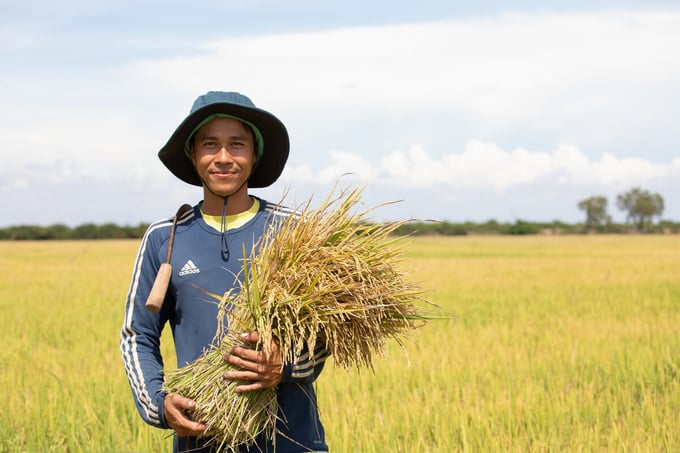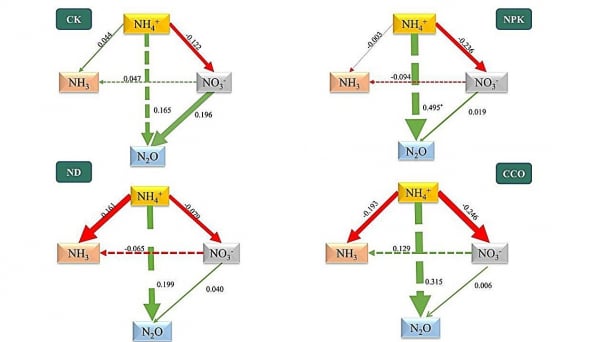June 25, 2025 | 07:23 GMT +7
June 25, 2025 | 07:23 GMT +7
Hotline: 0913.378.918
June 25, 2025 | 07:23 GMT +7
Hotline: 0913.378.918

A rice farmer in Cambodia.
The benchmark for world food commodity prices saw its fastest increase in 18 months in September, with quotations up for all covered commodity groups, led by sugar, the Food and Agriculture Organization of the United Nations (FAO) reported Friday.
The FAO Food Price Index, which tracks monthly changes in the international prices of a set of globally-traded food commodities, averaged 124.4 points in September, up 3.0 percent from August and 2.1 percent higher than its corresponding value a year earlier.
The FAO Sugar Price Index registered the largest increase in September, rising by 10.4 percent. This was driven by worsening crop prospects in Brazil and concerns that India’s decision to lift restrictions on sugarcane use for ethanol production may affect export availabilities from the country.
The FAO Cereal Price Index increased by 3.0 percent during the month, led by higher wheat and maize export prices. International wheat prices increased due largely to concerns over excessively wet conditions in Canada and the European Union, though this was partly offset by competitively priced supplies from the Black Sea region.
World maize prices also climbed, influenced by low water levels on key transportation routes along the Madeira River in Brazil and the Mississippi River in the United States of America. By contrast, the FAO All Rice Price Index declined by 0.7 percent, partly reflecting generally quiet trading activities.
The FAO Vegetable Oil Price Index increased by 4.6 percent from August, with higher quotations across the board for palm, soy, sunflower and rapeseed oils. The rise in international palm oil prices was due to lower-than-expected production in major Southeast Asian producing countries, while the rebound in soyoil quotations was primarily due to lower-than-expected crushings in the United States of America.
The FAO Dairy price Index rose by 3.8 percent in September, with quotations up for whole milk powder, skim milk powder, butter and cheese.
The FAO Meat Price Index increased by 0.4 percent, mainly due to higher poultry meat prices driven by strong import demand for Brazil’s product. World bovine and pig meat prices remained stable, while those for ovine meat declined slightly from August levels.
2024/25 forecasts raised for global rice output and trade
FAO raised marginally its forecast for global cereal production in 2024 to 2 853 million tonnes, reflecting upward revisions to rice and wheat outputs that outweighed a small reduction made to global coarse grains production.
The new figure, also published on Friday in the new Cereal Supply and Demand Brief, remains moderately below the record output of 2023.World wheat production is expected to increase by 0.5 percent in 2024 from the previous year, as improved yield prospects in Australia more than compensate for a significant cut to the European Union’s forecast due to excessively wet conditions.
By contrast, global production of coarse grains is now expected to decline by 0.8 percent from 2023, with smaller crops in the European Union foreseen to outweigh higher maize output anticipated in the United States of America.
World rice production in 2024/25 is now forecast to rise by 0.9 percent and reach a historical high of 539.2 million tonnes.
World cereal total utilization is forecast to rise by 0.4 percent to 2 853 million tonnes in 2024/25, while global cereal stocks are predicted to expand by 1.2 percent, with rice stocks seen increasing three times faster. This results in a global cereal stocks-to-use ratio of 30.6 percent, which FAO considers “adequate supply prospects in the new season.
”International trade in cereals is now forecast at 488.1 million tonnes, representing a 2.7 percent contraction from the 2023/24 level. However, it is seen that increasing imports by Africa and Near East could spearhead a recovery in international rice trade in 2025.
The Agricultural Market Information System (AMIS) also released its monthly Market Monitor on Friday, featuring, in addition to the regular analysis, a discussion on the role of trade in achieving Sustainable Development Goal 2.
(FAO)

(VAN) Researchers from the Institute of Applied Ecology of the Chinese Academy of Sciences have developed a new environmentally friendly fertilizer additive that significantly enhances crop yields while reducing emissions of harmful gases.

(VAN) Poultry production in Poland, which has only started recovering from devastating bird flu outbreaks earlier this year, has been hit by a series of outbreaks of Newcastle disease, with the veterinary situation deteriorating rapidly.

(VAN) Extensive licensing requirements raise concerns about intellectual property theft.

(VAN) As of Friday, a salmonella outbreak linked to a California egg producer had sickened at least 79 people. Of the infected people, 21 hospitalizations were reported, U.S. health officials said.

(VAN) With the war ongoing, many Ukrainian farmers and rural farming families face limited access to their land due to mines and lack the financial resources to purchase needed agricultural inputs.

(VAN) Vikas Rambal has quietly built a $5 billion business empire in manufacturing, property and solar, and catapulted onto the Rich List.

(VAN) Available cropland now at less than five percent, according to latest geospatial assessment from FAO and UNOSAT.